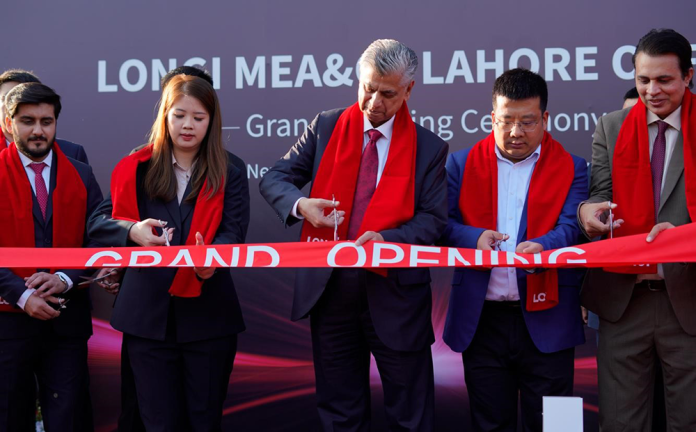“Our team will remain steadfast in working towards a sustainable future for the country,” Ali Majid, General Manager of Pakistan, LONGi Solar, pledged at the launching ceremony of the MEA&CA Office in Lahore. On November 12, the global leader in solar technology has just taken a crucial step toward a green and sustainable future in Pakistan.
Murtaza Solangi (R3) and Ali Majid (R1) cut the ribbon
“The energy crisis has always been an indispensable issue that needs to be solved by successive Pakistani governments,” Murtaza Solangi, Minister for Information and Broadcasting of Pakistan who attended the ceremony, emphasized in his speech.
“Since the establishment of the China-Pakistan Economic Corridor (CPEC) a decade ago, Chinese enterprises have continued to invest in the field of renewable energy,” the Minister mentioned, “we’re deeply grateful for their increased investment to help Pakistan get out of its energy dilemma and hope that the new office will play a pivotal role in not only promoting employment, but also further optimizing Pakistan’s existing energy structure.”

According to the National Electric Power Regulatory Authority’s (NEPRA) 2021 yearly report, Pakistan’s total installed power generation capacity is 39772 MW, of which 63 percent of energy comes from thermal (fossil fuels), 25 percent from hydro, 5.4 percent from renewable (wind, solar and biomass) and 6.5 percent from nuclear. The current proportion of renewable energy is far from enough. According to the revised Renewable Energy (RE) Policy, the government of Pakistan aims to derive 30 percent of energy from renewable sources by 2030 which would wean Pakistan’s dependence on imported fuel products.
Pakistan is located on a sunny belt with almost 300 days of sunshine per year and almost about 3000-3300 hours of sunshine per year. Receiving all this sunlight all year round, Pakistan has 2.9 million MW of solar power potential. Such unique conditions urgently require solar energy enterprises to promote transformation. In recent years, Pakistan has witnessed substantial investments in solar power projects, both domestic and foreign. It has introduced a financing scheme for renewable energy to make financing available for consumers in the private sector to invest in renewable electricity generation. Until February 2022, SBP had provided Rs74 billion (about USD 400 million) in financing to over 1,175 projects with a combined capacity of 1,375 MW in renewable energy.
“The world needs an energy transition to more solar power. Currently, even though the sun shines everywhere, 80 percent of the world’s energy is consumed by just 20 percent of the population, nearly 11 percent of people have no access to electricity and one-third of the population has no access to clean energy for cooking. We know harnessing solar power across the globe will improve local economies and the lives of billions of people.” Li Zhenguo, founder and president of LONGi, noted, also as a featured speaker at the ongoing Asia Pacific Economic Cooperation (APEC) CEO Summit in San Francisco on November 15.

As solar energy attracts more capital than oil for the first time ever, Pakistan stands at a crucial juncture. By embracing the potential of solar energy and implementing the necessary measures, Pakistan can secure a sustainable, clean, and reliable energy future while reaping the economic benefits that come with the global shift towards renewable energy sources.


